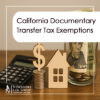
The purpose of this article is to explain what a Transfer on Death (TOD) Deed is. TOD Deeds are designed to help people, especially the elderly, transfer their residential property more easily and at a lower cost. These deeds allow property transfer without the need for a will or living trust, which would typically require going through probate.
Before January 2016, the only ways to transfer property after the owner’s death were through joint tenancy with right of survivorship, probate, or a trust transfer deed. The laws establishing TOD Deeds were initially set to expire in 2021 but have been extended to 2032.
What is a Transfer on Death Deed?
A TOD Deed allows the property owner (grantor) to transfer their property by filling out and notarizing a form. This form must include the current owner’s name, a precise legal description of the property, and the name of the beneficiary. The grantor must sign and date the deed, and under 2022 amendments, witnesses must also sign. These witnesses must either see the grantor sign or hear them acknowledge the signature. The deed must be recorded with the county recorder’s office within 60 days of notarization (Cal. Prob. Code § 5626, 5632).
The TOD Deed takes effect only after the grantor’s death, transferring ownership to the named beneficiary. Due to its binding nature, it’s crucial that the grantor fully understands the implications of creating this deed.
The grantor can name more than one beneficiary, specifying whether they will hold the property as joint tenants with rights of survivorship or as tenants in common. The grantor can revoke the TOD Deed at any time by recording a revocation form or a new deed within 60 days of notarization, allowing for flexible estate planning.
Married couples can also create TOD Deeds, with the property transferring to the beneficiary only after both spouses have passed away. The surviving spouse retains the right to revoke the deed.
What Does This Mean for the Beneficiary?
The beneficiary inherits the property upon the grantor’s death. However, there are specific steps to follow. Amendments in 2022 allow the grantor to name multiple beneficiaries, a trust, or a legal entity as beneficiaries (Cal. Prob. Code § 5608). The grantor can also name alternate beneficiaries in case the primary one is not alive at the time of their death. Ownership interests must be equally divided if there are multiple beneficiaries, and if no beneficiaries survive, the property will likely go through probate.
Upon the grantor’s death, the beneficiary must notify the grantor’s heirs and file an affidavit confirming the notification. This notice, often in the form of a formal letter, explains the TOD Deed’s effect and informs the heirs of their right to contest the transfer. To claim the property, the new owner must file an affidavit and the grantor’s death certificate with the recorder’s office.
The beneficiary may be liable for the grantor’s debts, including credit card debts, for up to three years. While the TOD Deed simplifies property transfer, it has both advantages and disadvantages.
Advantages of TOD Deeds
TOD Deeds offer several benefits. They can be less costly than a living trust and eliminate the need for probate, saving on probate taxes. The grantor can avoid federal gift tax paperwork since the property is not considered a gift until the grantor’s death. The ability to revoke the deed allows the grantor to maintain control and ownership during their lifetime. Unlike a will, a TOD Deed avoids the lengthy and expensive probate process. Additionally, transferring property through a TOD Deed does not affect Medicaid eligibility since it is not an immediate transfer.
Drawbacks of TOD Deeds
However, TOD Deeds have some limitations. They are restricted to certain types of residential property (Cal. Prob. Code § 5624). Due to the detailed requirements, errors in the form can render the deed void, often necessitating legal assistance. Beneficiaries are not protected from the grantor’s debts for three years, making it difficult to obtain title insurance and potentially delaying the sale of the property.
The simplicity of a TOD Deed can also make it susceptible to undue influence from family members. Conflicts between a TOD Deed and a will can complicate probate proceedings. If the grantor received long-term care through MediCal, the property might be subject to recovery claims by California, potentially affecting the beneficiary’s inheritance.
Example of a TOD Deed
Julie wants to transfer her house to Shawn, one of her four sons, upon her death, so she uses a TOD Deed. She properly fills out the form, specifying the property and Shawn’s relationship to her.
If Julie decided to leave the house to all four sons, she would need to specify whether they are joint tenants or tenants in common. Each brother would receive a 25% share. Julie must name each son individually; listing “to my four sons” is insufficient.
If Julie and Shawn have a falling out, she can revoke the deed and designate another son as the beneficiary, recording the new deed within 60 days. If all four brothers object to her choosing only one son, she can revoke the deed and explore other estate planning options.
Upon Julie’s death, Shawn, listed on the TOD Deed, must file an affidavit and Julie’s death certificate at the recorder’s office to claim the house. He must also notify his three brothers as Julie’s heirs. If another brother feels entitled to the house, he may contest the transfer. Additionally, Shawn assumes responsibility for Julie’s debts. If she has substantial debts, creditors may pursue Shawn, potentially causing him to lose the house.
Conclusion
Transfer on Death (TOD) Deeds offer a streamlined and cost-effective way to transfer property upon the owner’s death, bypassing the lengthy and expensive probate process. While they provide several advantages, including flexibility, avoidance of federal gift taxes, and Medicaid eligibility preservation, they also come with specific limitations and risks. Beneficiaries may be liable for the grantor’s debts, and the rigid nature of the deed’s requirements can lead to complications if not handled correctly. Understanding both the benefits and potential drawbacks of TOD Deeds is essential for anyone considering this method of property transfer.
For expert guidance on setting up a Transfer on Death Deed or to learn more about its advantages in estate planning, visit www.voklaw.com or call (855) 855-2608. Our team of professionals is ready to assist you in securing your property’s future with clarity and efficiency.






